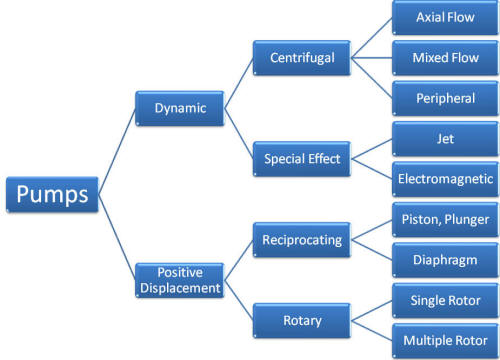| Pumps may be classified on the basis of the applications they serve, the materials from which they are constructed, the liquids they handle, and even their orientation in space. All such classifications, however, are limited in scope and tend to substantially overlap each other. A more basic system of pump classification is based on the principle by which energy is added to the fluid. Under this system, all pump types generally fall into two main categories. |
These are further divided into many forms. For simplification of article we will discuss these many forms separately in separate articles. |
|
|
Difference between Dynamic and Positive Displacement Pumps
|
Factor |
Dynamic (Centrifugal) Pump |
Positive Displacement Pump |
|
Mechanics |
Impellers pass on velocity from the motor to the liquid which helps move the fluid to the discharge port (produces flow by creating pressure). |
Traps confined amounts of liquid and forces it from the suction to the discharge port (produces pressure by creating flow). |
|
Performance |
Flow rate varies with a change in pressure. |
Flow rate remains constant with a change in pressure. |
|
Viscosity |
Flow rate rapidly decreases with increasing viscosity, even any moderate thickness, due to frictional losses inside the pump. |
Due to the internal clearances high viscosities are handled easily and flow rate increases with increasing viscosity. |
|
Efficiency |
Efficiency peaks at a specific pressure; any variations decrease efficiency dramatically. Does not operate well when run off the middle of the curve; can cause damage and cavitation. |
Efficiency is less affected by pressure, but if anything tends to increase as pressure increases. Can be run at any point on their curve without damage or efficiency loss. |
|
Suction Lift |
Standard models cannot create suction lift, although self-priming designs are available and manometric suction lift is possible through a non return valve on the suction line. |
Create a vacuum on the inlet side, making them capable of creating suction lift. |
|
Shearing |
High speed motor leads to shearing of liquids. Not good for shear sensitive mediums. |
Low internal velocity means little shear is applied to the pumped medium. Ideal for shear sensitive fluids. |

